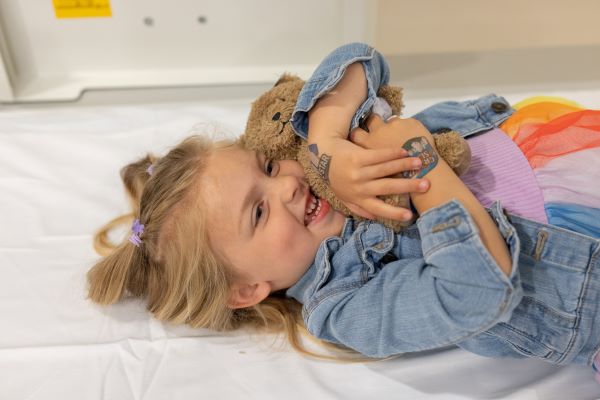Voiding Cystourethrogram (VCUG)
Call today to schedule an appointment with one of our pediatric specialists.
Radiology Referrals
A VCUG (Voiding Cystourethrogram) uses x-rays and a contrast material to check your child’s urethra and bladder size, shape and capacity. The contrast material is administered by a catheter into your child’s bladder. Then, images of the bladder and kidneys are taken as the bladder fills and while your child urinates (pees). These images will help your doctor check for problems in the urinary system.

The CHOC Difference

- CHOC has been designated a Diagnostic Imaging Center of Excellence® (DICOE) by the American College of Radiology (ACR) for best-quality imaging practices and diagnostic care.
- CHOC uses only board-certified pediatric radiologists and specially trained pediatric radiology technologists, nurses and child life specialists.
- All radiology staff undergo age-specific training annually to learn how to work and communicate with children of varying ages.
- We are only one of a few medical centers in the country to have child life specialists working in a dedicated pediatric radiology and imaging department.
What is fluoroscopy?
A VCUG is a fluoroscopy procedure. This is an imaging technique that uses x-rays to create “real-time” or moving images of the body. It helps doctors see how an organ or body system functions. A radiologist, radiologic technologist and nurse perform the procedures together. In most of these types of exams, your child will lie on the table while the x-ray machine is brought overhead. The x-ray machine has a curtain on it; its like being in a small car wash or in a tent.
Why are VCUG’s done?
A VCUG will show your physician how your child’s urinary tract functions. It can check the bladder’s size and shape and look for problems, such as a blockage along the path of urine. It can also show whether pee is moving in the wrong direction. Normally, pee flows from the kidneys down to the bladder through the ureters. When it goes the wrong direction (back up toward the kidneys), its call vesicoureteral reflux (VUR). A VCUG can detect VUR. Sometimes this problem only happens when a person is urinating (voiding). That’s the reason why the VCUG must include taking images while the bladder is being emptied. Because VUR can cause urinary tract infections (UTIs), this test is sometimes recommended after a child has had a UTI. Not all kids who have had UTIs have reflux, but its important to find those who do so it can be treated.
What to expect: Preparing for a VCUG
How do we prepare for a VCUG?
A VCUG doesn’t need any special preparation before the exam. Dress your child comfortably in clothes that are easily removed. Your child will be given a gown to change into for the procedure. One parent will be allowed to go with their child into the exam room. Other arrangements should be made for siblings. Women who are pregnant or could be pregnant will be asked to leave the exam room during the procedure. Please make sure someone else is available to go with your child during the exam, if needed.
What happens during a VCUG?
A VCUG takes 30-60 minutes.
- The technologist will ask why the VCUG is being performed and will explain the procedure to you and your child.
- Your child’s bladder will need to be catheterized for this exam. Your child will lay on the x-ray table with their legs in a “butterfly position” or “frog position.”
- The technologist or nurse will wipe down the urethral area with three to four cotton balls soaked in “brown soap” which is an iodine-based cleaner. The soap may feel a bit cool.
- A tiny catheter will be placed into your child’s bladder. Your child may feel some pressure and the sensation or urge to urinate. As a relaxation technique during this process, we will ask your child to “blow out birthday candles” or to take deep breaths.
- Once the catheter is placed the technologist or nurse will secure the tube to your child’s leg with a piece of tape.
- The catheter will be connected to a bottle of contrast material that can be seen on the x-ray screen. The contrast material will flow through the urinary catheter into your child’s bladder.
- The radiologist and technologist will then pull the x-ray machine over your child and will take several x-rays. Your child will be asked to roll side to side at times and told to hold the contrast in even though they might feel the urge to urinate.
- Once the bladder is full the radiologist will ask your child to urinate while still on the table. Small children and infants will probably urinate on their own. Older children will be asked to hold it until their bladder is full, then asked to urinate. If your child is unable to urinate on their own the technologist might pour a little warm water to help them urinate.
Once your child starts to urinate, more x-rays will be taken. While your child is urinating, the catheter will slide out without your child feeling discomfort. A few more x-rays will be taken to complete the test. We have child life specialists that can help prepare and support your child during the test. They will explain it to them in a developmentally appropriate way. Our child life specialists can also provide distraction techniques.
What should you do after the exam?
There are no special instructions for your child to follow when the procedure is over.
How do I get my VCUG results?
Once your child’s procedure is over the Radiologist will go over the images and will send the report to your ordering physician within 5-7 business days. You will receive your results from your child’s ordering physician.
